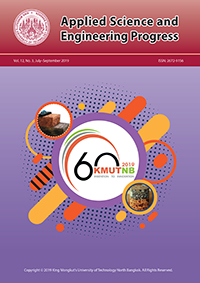Model-robust G-optimal Designs in the Presence of Block Effects
Main Article Content
Abstract
Due to the uncertainty of possible reduced models prior to data collection, this paper considered using experimental designs that are robust across the set of potential models. In this study, blocking effects were combined into all possible models which were obtained from weak heredity principle (WH). The objective of this article was to propose the geometric mean of G-optimalities as a new alternative for finding robust response surface designs against model misspecification. The proposed criterion is so-called a weighted G-optimality criterion (Gw). The genetic algorithm (GA) was employed to optimize the weighted G-optimality criterion for finding designs. Robust designs having 2 and 3 design variables in hypercube were generated with an appropriate number of design points in each blocks and the number of blocks in this study are 2, 3, and 4. The scheme for weighting the criteria was to give more weight to a model with a larger number of parameters. The resulting weighted G-optimal designs have higher G-efficiencies compared to those of G-optimal designs if a true model is the first-order or interaction models. The G-efficiency of a weighted G-optimal design is slightly less than that of a G-optimal design even when the true model is a second-order model. Furthermore, design points identified from the GA are also presented, which would be very useful in practice for those intending to implement an experimental design for data collection.
Article Details
References
[2] K. Smith, “On the standard deviations of adjusted and interpolated values of an observed polynomial function and its constants and guidance they give towards a proper choice of distribution of observations,” Biometrika, vol. 12, no. 1/2, pp. 1–85, Nov. 1918.
[3] A. C. Atkinson, A. N. Donev, and R. D. Tobias, Optimum Experimental Designs with SAS. Oxford, England: Clarendon, 2007.
[4] H. A. Chipman, “Bayesian variable selection with related predictors,” The Canadian Journal of Statistics, vol. 24, no. 1, pp. 17–36, 1996.
[5] B. Chomtee and J. J. Borkowski, “Weighted design optimality criteria for spherical response surface designs,” KMITL Science Journal Issue, In Proceedings of the 2nd International Symposium on Mathematical, Statistical and Computer Sciences, vol. 5, pp. 226–238, 2005.
[6] A. Chairojwattana, S. Chaimongkol, and J. J. Borkowski, “Using genetic algorithms to generate Dw- and Gw-optimal response surface designs in the hypercube,” Thailand Statistician, vol. 15, no. 2, pp. 157–166, Jul. 2017.
[7] W. Limmun, J. J. Borkowski, and B. Chomtee, “Weighted A-optimality criterion for generating robust mixture designs,” Computers and Industrial Engineering, vol. 125, pp. 348–356, 2018.
[8] W. Limmun, B. Chomtee, and J. J. Borkowski, “The construction of a model-robust iv-optimal mixture designs using a genetic algorithm,” Mathematical and Computational Application, vol. 23, no. 2, pp. 1–13, 2018.
[9] J. H. Holland, Adaptation in Natural and Artificial System: An Introductory Analysis with Applications to Biology Control, and Artificial Intelligence. Oxford, England: University of Michigan Press, 1975.
[10] S. N. Sivanandam and S. N. Deepa, Introduction to Genetic Algorithms. Berlin, Germany: Springer, 2008.
[11] J. J. Borkowski, “Using a genetic algorithm to generate small exact response surface designs,” Journal of Probability and Statistical Science, vol. 1, no. 1, pp. 69–92, 2003.
[12] S. Thongsook, J. J. Borkowski, and K. Budsaba, “Using a genetic algorithm to generate Dsoptimal designs with bounded D-efficiencies for mixture experiments,” Thailand Statistician, vol. 12, no. 2, pp. 191–205, Jul. 2014.
[13] S. Mahachaichanakul and P. Srisuradetchai, “Applying the median and genetic algorithm to construct D- and G-optimality robust designs against missing data,” Applied Science and Engineering Progress, vol. 12, no. 1, pp. 3–13, 2019.


